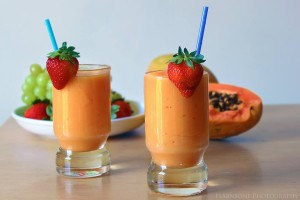 Do you currently start each day with a glass of freshly prepared juice or a "green smoothie”? More and more people are jumping on the juicing bandwagon after reading about the great many benefits it can provide.
Do you currently start each day with a glass of freshly prepared juice or a "green smoothie”? More and more people are jumping on the juicing bandwagon after reading about the great many benefits it can provide.
And it’s true. Juicing, when done wisely, can offer some benefits. But, it can also become a problem.
Learning the truth about drinking juices and smoothies will help you better manage these in the context of your overall diet plan.
Here’s what to know.
The Issue With Liquid Calories
The first potential problem to be aware of is that most people won’t get full off of liquid calories like they will solid food.
Think about this for a minute. Which will you feel more full and satisfied after – three oranges or a glass of orange juice?
The answer is quite clear. Most people couldn’t eat three oranges in a sitting, yet, both of these examples have approximately the same calorie equivalent.
If you’re drinking a couple of juices or smoothies a day, particularly if they’re prepared with fruits or healthy fats, you could easily be tallying 300-500 calories, or more.
If you do this in addition to eating the foods you normally eat, that’s enough to lead to some fat gain without even feeling like you're overeating.
So here’s lesson one:
Make sure you’re aware of how many calories you’re drinking and account for them.
If you’re already dieting, these beverages just won’t provide you with the same satiety whole foods will.
Keep An Eye On The Ingredients In Your Beverage
The second thing to look at is the ingredients you are adding. While juicing some fresh berries with vegetables isn’t all that bad, if you’re adding a whole banana, an apple, some berries, along with other fruits into that smoothie or juice, you’re getting a whole lot of sugar all at once.
This leads to blood glucose spikes, energy crashes, and a higher likelihood of overeating.
Don’t let this make you think that fruits are bad – quite the opposite. They are packed full of nutrients and are a staple part of the Bikini Body Nutrition Guide.
But, they are best consumed in the whole food form, especially if you want to lose fat.
It’s just too easy to overeat and over consume carbohydrates if you're drinking tons of fruit juice.
So here is the second lesson:
Balance your juices or smoothies with a modest amount of fruits, some vegetables, along with other ingredients like unsweetened almond milk, protein powder, avocados, or nut butter.
These ingredients will also slow down the release of the sugars, keep your total sugar intake in check, and keep you satisfied longer.
The Disregard For Other Important Nutrients
Another big issue with the juicing trend is that many people get stuck on the notion that juice ‘cleanses’ (or detoxes) are a great way to jumpstart the metabolism and boost fat loss.
It’s quite the opposite.
Don’t let yourself think you can go all day simply by juicing some fresh fruits and vegetables.
You need lean proteins and healthy fats in there too. And You won’t get those from your juices.
Trying to exist all day long on a few juices will promote the loss of lean muscle mass (which helps you look lean and toned at the beach), and leave you malnourished and lacking energy.
So, here is lesson three:
Seek balance.
Juicing doesn’t have to be an all or none phenomenon.
A juice here and there on days you can’t get in adequate fruits and/or vegetables is a smart move.
A diet consisting of all juice or smoothies is not.
The Potential Of Gastrointestinal Distress
Finally, the last issue with the juice and smoothie trend is that it can mean taking in a good 3-5 servings of vegetables all at once.
This can quickly mean gas, bloating, and possibly diarrhea. Don’t go from zero to sixty in one day or you’ll be doubled up and in pain by the evening.
So, your final lesson is to monitor how you feel and increase your intake of vegetables over time.
If you follow these tips, you can enjoy the taste of your juices or smoothies, control your body weight, and reap the health benefits they bring.
P.S. If you're sick of all the misinformation out there around healthy eating and getting lean, then check out the Bikini Body Nutrition Guide.
You get an exact meal plan for building your Bikini Body, including what to eat, how much, and when.
Plus, there are tons of healthy recipes to keep your diet from getting boring.
Check it out HERE.
